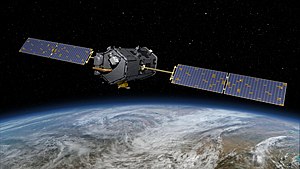Orbiting Carbon Observatory 2
| OCO-2 | |
|---|---|

|
|
| Type: | Research satellite |
| Country: |
|
| Operator: |
|
| COSPAR-ID : | 2014-035A |
| Mission dates | |
| Dimensions: | 407 kg |
| Begin: | July 2, 2014, 09:56 UTC |
| Starting place: | Vandenberg SLC-2W |
| Launcher: | Delta 7320-10C D367 |
| Orbit data | |
| Rotation time : | 98.8 min |
| Track height: | 711 km |
| Orbit inclination : | 98.2 ° |
| Perigee height : | 709 km |
The Orbiting Carbon Observatory 2 , or OCO-2 for short, is a US satellite that was put into orbit on July 2, 2014. The satellite measures the carbon dioxide concentration in the atmosphere with great precision.
Launch of the satellite
The OCO-2 satellite was built by Orbital Sciences Corporation . The built-in instruments measure the carbon dioxide concentration and distribution in the atmosphere. The launch took place at Vandenberg Air Force Base on July 2, 2014 at 09:56 UTC with a Delta II rocket within a 30-second launch window. The satellite flies in a sun-synchronous orbit .
Measurements
The satellite measures the reflection of sunlight by carbon dioxide in the atmosphere. The measurement takes place over different spectral ranges. The data will be evaluated in the NASA Goddard Earth Science Data and Information Services Center (GES DISC).
The resolution is so good that the carbon dioxide emissions of cities can be determined. The satellite was used to observe the El Niño phenomenon . During this investigation, it was found that the terrestrial biomass in the tropical areas of Southeast Asia, South America and Africa bring the same amount of carbon dioxide into the atmosphere. The reason for the increased production of carbon dioxide in Southeast Asia was mainly forest fires caused by the dry climate. In South America, the dry weather led to a lower productivity of the plants and thus a reduced carbon dioxide uptake. In Africa, the increased heat led to increased plant respiration and thus increased carbon dioxide emissions.
Web links
- ESA: OCO-2 (Orbiting Carbon Observatory-2) (English)
- Goddard Earth Sciences Data and Information Services Center (GES DISC) website
Individual evidence
- ↑ Railway data according to OCO 2. N2YO, October 13, 2017, accessed on October 14, 2017 (English).
- ↑ Andrea Thompson: NASA Satellite Reveals Source of El Niño-Fueled Carbon Dioxide Spike. Live Science, October 12, 2017, accessed October 14, 2017 .
